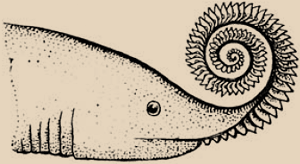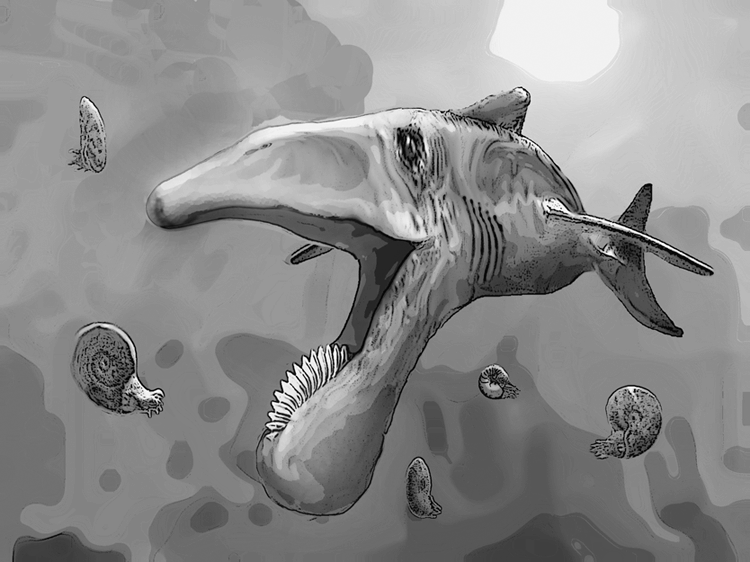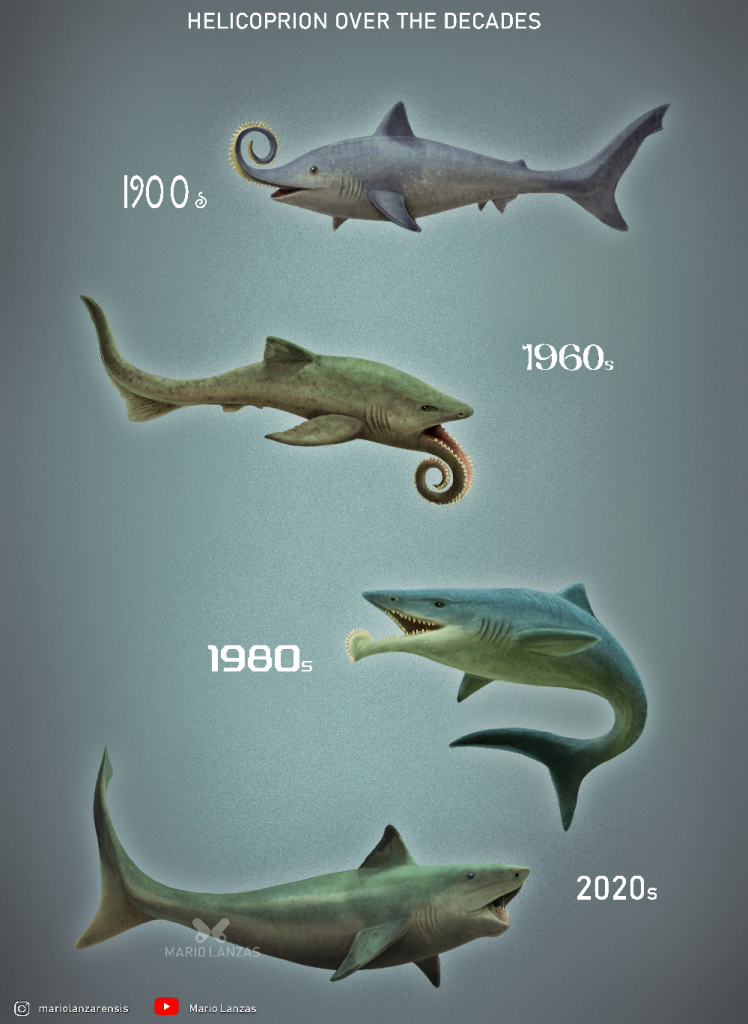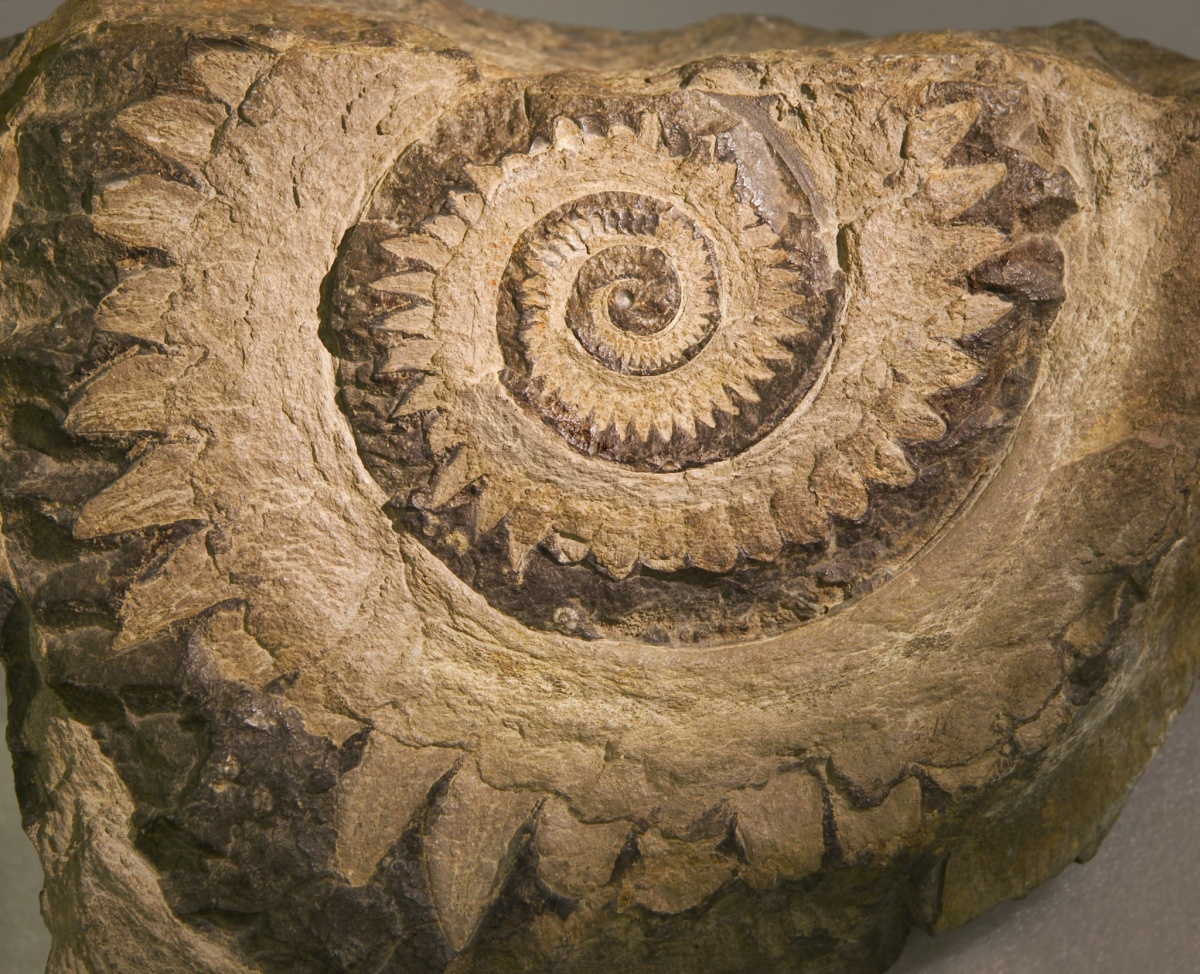Paleontology is ultimately an exercise in puzzle solving, and some puzzles are harder than others.
Take the mystery of Helicoprion, for example.
In 1886, English paleontologist Henry Woodward described a strange fossil from Western Australia. Woodward believed the curved, jagged fossil represented a “fish-spine” akin to specimens of the genus Edestus vorax discovered in North America three decades prior[i]. The true nature of the fossil would later be revealed in 1899 when geologist Alexander Karpinsky discovered a more complete specimen in the Ural Mountains of western Russia[ii]. Karpinsky correctly identified the specimen as a bizarre set of teeth belonging to an ancient shark. He named it Helicoprion, or the “spiral saw” shark.

As the name suggests, Helicoprion’s bizarre dentition resembles a modern buzzsaw. The spiral shape of the dental root, known as “tooth whorls,” are a unique trait not found in any other animal. Large tooth whorls can be over 50 centimetres (20 inches) long and contain over 150 teeth, giving them a formidable appearance. Given their unique condition and the lack of modern analogues, paleontologists have always questioned how Helicoprion used this bizarre tool to their advantage.
But before they could solve how Helicoprion used their whorls, they needed to figure out where the whorls were situated.
The challenge for paleontologists is that the skeleton of Helicoprion was made of cartilage. Unlike bone, cartilage is rarely preserved in the fossil record, meaning all estimations of Helicoprion’s appearance were based solely on the tooth whorls. Karpinsky initially believed the whorls would have curled upwards at the tip of the snout. An alternate theory was proposed by American paleontologist Charles Eastman in 1900, who suggested the whorls may have represented a “spine” present somewhere along the back of Helicoprion[iii].

Eastman’s views became accepted by many, including Karpinsky. Many depictions at the beginning of the 20th century featured the whorls on either the dorsal fin or the upper lobe of the caudal fin (tail). While these notions may seem odd, shark anatomy gave paleontologists reasonable grounds to make these assumptions. Shark bodies are covered in thousands of overlapping projections called placoid scales, which shark teeth originated from. Given this, it’s not unreasonable that paleontologists assumed primitive sharks like the 270-million-year-old Helicoprion could have had strange dermal features at numerous locations on their bodies.
In the decades after Eastman and Karpinsky, additional specimens provided more insights into Helicoprion. While debate continued, a consensus emerged that the tooth whorls were part of the lower jaw. A 2009 study by Oleg Lebedev provided a clearer picture, situating the tooth whorl on the end of an elongated lower jaw with a gap in the upper jaw designed for fitting the whorl[iv]. This depiction was getting closer, but it wouldn’t be until 2013 that the appearance of Helicoprion was revealed.

Instead of a new find, the ground-breaking specimen that settled the Helicoprion debate was found decades before its redescription. In 1950, paleontologists working in phosphorous mines in Idaho, USA, discovered a unique specimen of Helicoprion with cartilage alongside a tooth whorl[v]. While the cartilage was noted in a 1966 description of the fossil, it was thought that the crushed nature of the specimen made further analysis impossible.
This remained the case until 2013 when modern CT imaging technology allowed researchers to examine the fossil. The team, led by Leif Tapanila of Idaho State University, found that the tooth whorl encompassed the entire lower jaw of Helicoprion and that the lower jaw was not elongated[vi]. Lebedev’s conclusions on the upper jaw proved correct, as Tapanila’s team also found the upper jaw to be devoid of teeth.

The most shocking conclusion of the study was that Helicoprion wasn’t a shark! Instead, a few traits of the cartilage point to Helicoprion being part of Holocephali, the family that includes extant chimaeras and ratfish. While they are part of Chondrichthyes, the order that includes sharks and rays, Holocephalans diverged from their cartilaginous cousins over 400 million years ago[vii]. To put that into perspective, reptiles and mammals diverged from each other almost 100 million years after Helicoprion and its relatives did from sharks!
One question remains unanswered: how did Helicoprion use its jaws? Early descriptions believed multiple tooth whorls worked in tandem to crush hard-shelled ammonites, but this seems impossible under the 2013 single-whorl model. Instead, paleontologists now believe Helicoprion used its jaws to slice through soft-bodied prey like squid[viii]. In this way, the tooth whorls were used like prehistoric pizza cutters, slicing through aquatic prey with ease and pulling their remains into the back of their mouths.

It’s unclear why Helicoprion developed such a strange trait, but it served them well. Helicoprion fossils are found worldwide and could grow to over 6 meters in length (20 feet), longer than the average Great White Shark![ix] While Helicoprion disappeared in the mid-Permian, their legacy has remained etched in stone for millennia, baffling paleontologists brave enough to try and decipher their strange anatomy.
Happy Shark Week! I realize Helicoprion isn’t technically a shark, but many still think of it as one, so it should count! If that’s not enough for you, I suggest you read about I suggest you read about why Megalodon is definitely extinct, here at Max’s blogosaurus.
I do not take credit for any images found in this article. Header image courtesy of Kenyon Roberts on twitter, found here.

Works Cited
[i] Woodward, Henry. “On a Remarkable Ichthyodorulite from the Carboniferous Series, Gascoyne, Western Australia.” Geological Magazine, vol. 3, no. 1, 1886, pp. 1–7, https://doi.org/10.1017/s0016756800144450.
[ii] Crew, Becky. “Prehistoric Ghost Shark Helicoprion’s Spiral-Toothed Jaw Explained.” Scientific American Blog Network, 27 Feb. 2013, blogs.scientificamerican.com/running-ponies/prehistoric-ghost-shark-helicoprions-spiral-toothed-jaw-explained/.
[iii] Eastman, C. R. “Karpinsky’s Genus Helicoprion.” The American Naturalist, vol. 34, no. 403, 1900, pp. 579–582, https://doi.org/10.1086/277706.
[iv] Lebedev, O. A. “A New Specimen of Helicoprion Karpinsky, 1899 from Kazakhstanian Cisurals and a New Reconstruction of Its Tooth Whorl Position and Function.” Acta Zoologica, vol. 90, 2009, pp. 171–182, https://doi.org/10.1111/j.1463-6395.2008.00353.x.
[v] Crew, Becky. “Prehistoric Ghost Shark Helicoprion’s Spiral-Toothed Jaw Explained.” Scientific American Blog Network, 27 Feb. 2013, blogs.scientificamerican.com/running-ponies/prehistoric-ghost-shark-helicoprions-spiral-toothed-jaw-explained/.
[vi] Tapanila, Leif, et al. “Jaws for a Spiral-Tooth Whorl: CT Images Reveal Novel Adaptation and Phylogeny in Fossil Helicoprion.” Biology Letters, vol. 9, no. 2, 2013, p. 20130057, https://doi.org/10.1098/rsbl.2013.0057.
[vii] Inoue, J. G., et al. “Evolutionary Origin and Phylogeny of the Modern Holocephalans (Chondrichthyes: Chimaeriformes): A Mitogenomic Perspective.” Molecular Biology and Evolution, vol. 27, no. 11, 2010, pp. 2576–2586, https://doi.org/10.1093/molbev/msq147.
[viii] “Buzzsaw Jaw Helicoprion Was a Freaky Ratfish.” Science, 26 Feb. 2013, http://www.nationalgeographic.com/science/article/buzzsaw-jaw-helicoprion-was-a-freaky-ratfish.
[ix] “How Big Are Great White Sharks?” Smithsonian Ocean, 11 May 2023, ocean.si.edu/ocean-life/sharks-rays/how-big-are-great-white-sharks#:~:text=The%20biggest%20great%20white%20sharks,our%20great%20white%20shark%20overview.

One reply on “Blade Runner: Helicoprion & The Strangest Jaws in the Fossil Record”
[…] content. If you are interested in reading about other prehistoric sharks, I suggest you read about Helicoprion and the strangest jaws in the fossil record, here at Max’s […]
LikeLike